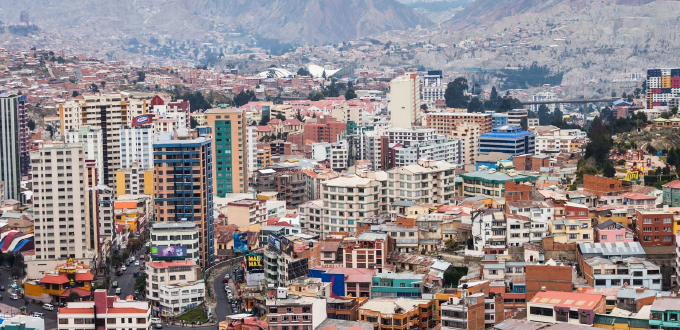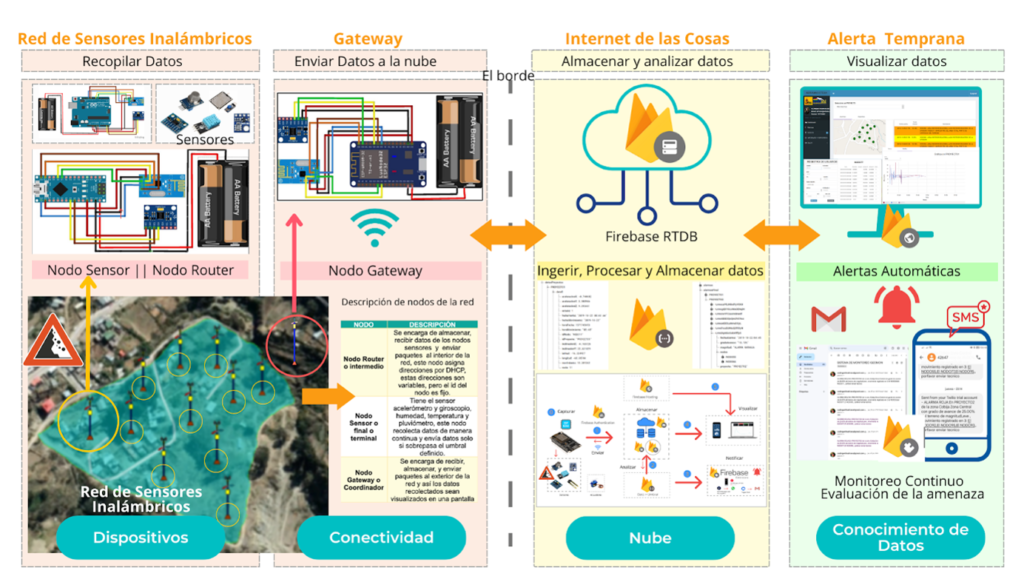Using the Internet to Warn About Natural Disasters in La Paz
08/08/2023

Adriana Ticonipa Gutiérrez has always lived in La Paz, Bolivia. Throughout history, this city has been prone to numerous natural disasters with more than 70 landslides standing out among them. The climate crisis has intensified meteorological events such as heavy rainfall and seismic activity, which are factors that increase the risk of landslides. This poses a significant threat to urban sustainability, personal well-being, biodiversity, and the overall health of terrestrial ecosystems.
Motivated by a strong sense of social commitment to her homeland, Adriana Ticonipa Gutiérrez decided to focus her professional career on providing solutions, aligned with the Sustainable Development Goals, to various emerging issues faced by Bolivian society. This is how she drew inspiration from her knowledge of systems to develop a Monitoring System for the Detection of Landslides in Risk Areas Through IoT and WSN.
This project was selected by LACNIC’s IT Women Mentoring Program to receive support from a tutor, free access to courses and training. Her proposal consisted of implementing one of the emerging technologies such as the Internet of Things based on a Wireless Sensor Network in a mesh topology.

The expert conducted an analysis of risk areas in La Paz, including the causes and factors that generate landslides. Her work also incorporated a documentary and experimental research on landslides, taking as a reference her undergraduate project. In order to identify monitoring variables, the study area, and the current procedure, she used the Top-Down Approach to develop the network design, implement the system, and carry out their respective tests.
Due to the danger of landslides, La Paz uses the USAT-GAMLP for hydrometeorological and geodynamic monitoring. One of the techniques used to identify the magnitude of surface movement is the use of geodynamic monitoring cores, which are designed to oversee the behavior of landslides when cracks arise due to earth shifts. However, this manual monitoring lacks automatic alerts (because of its manual nature) and has no continuity in the measurement process. This also jeopardizes the safety of the technical personnel.
The monitoring system promoted by Ticonipa Gutierrez considers that, although core monitoring is based on earth movements, it is also relevant to evaluate other factors such as humidity, ambient temperature, precipitation, and earth movements. This accurate, real-time, and long-term information is useful for further analysis.
The efforts undertaken by Adriana Ticonipa resulted in the creation of a continuous monitoring system based on IoT and a wireless sensor network, as an alternative approach to the currently employed method. The system also involves the generation of automatic alerts to take preventive actions in a timely manner and better understand the behavior of landslides in order to avoid economic and human losses. The project is associated with the achievement of Sustainable Development Goals 11 and 13: climate action and more resilient and sustainable cities. The project has already been carried out experimentally as a pilot test and has generated alerts according to the magnitude and degree of progress.
Ticonipa expects the Early Warning System Unit to implement this proposed system. In this regard, she states: “It is important to note that this system is scalable, as landslide monitoring consists of various monitoring systems and different monitoring variables. Each of these contributes valuable information to the system. In addition to the monitoring variables such as ground movement and slope angles, there are other factors that can be incorporated into landslide analysis, such as the history of landslides, as well as the climatic, geological, and meteorological conditions. Therefore, collected data bears importance, as it will be used for further analysis. We can issue real-time alerts and store the data in Firebase for further analysis.”
According to the Engineer, the suggested system is cost-effective and enables real-time data transmission to the cloud. However, it is necessary to consider other monitoring systems such as satellite image analysis, geographic information systems, artificial intelligence, and the incorporation of mathematical models, among others. Integrating diverse systems is recommended to achieve a comprehensive understanding of this subject. “We want to contribute to more effective landslide management and mitigation of their negative effects,” Ticonipa commented.
“Technology allows us to explore different areas,” she added. Despite my academic background in Systems Engineering, I was introduced to the world of natural disasters and climate change, which motivates me to learn more about it. “I want to encourage more people to use technology to provide solutions to various emerging problems in our society based on the Sustainable Development Goals. I hope this can serve as a doorway, an opportunity to seek support, and that these initiatives and projects can eventually be implemented,” she concluded.
To support similar initiatives, there is a new edition of the IT Women Mentoring Program. Click here to find all the information.